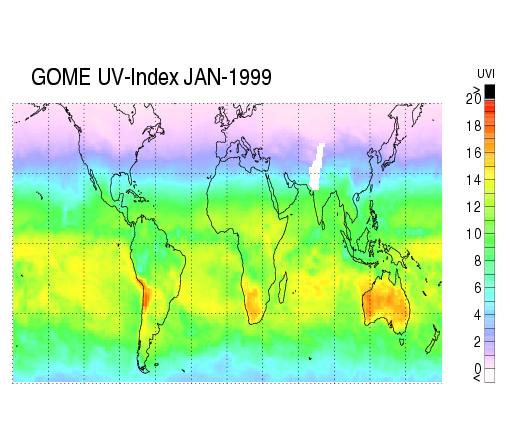UV Index from GOME
Introduction
The ultraviolet part of the solar spectrum plays an important role in many processes in the biosphere. It has several beneficial effects but it may also be very harmful. If the amount of UV radiation is sufficiently high the self protection ability of some biological species is exhausted and the subject may be severely damaged. This also concerns the human organism, in particular the skin and the eyes.
The diurnal and annual variability of solar UV radiation is governed by astronomical and geographical parameters as well as by atmospheric conditions. The most important factors affecting the UV radiation reaching the ground are atmopsheric ozone, the solar elevation, altitude, atmospheric scattering, clouds and haze and ground reflection. Most of the UV-B radiation is absorbed in the stratosphere by ozone molecules and only a few percent reach the surface. The solar elevation is the angle between the horizon and the direction to the sun. For high solar elevations the UV radiation is more intense because the rays from the sun have a shorter path through the atmosphere and therefor pass through a smaller amount of absorbers. As the UV irradiance depends strongly on the solar elevation it changes with latitude, season and time, being highest in the tropics, in summer and at noon. The UV irradiance is higher when the sky is cloudless. Clouds generally reduce the UV irradiance. The attenuation depends on both the geometrical and optical thickness of clouds.
Method
Radiative transfer calculations using the total ozone information from GOME determine the clear-sky surface UV flux. Cloud information are derived from estimation of the Lambertian Equivalent Reflectivity (LER), which is defined as the surface albedo in an aerosol and cloud free atmosphere that provides the appropriate top-of-atmosphere radiance observed by GOME. High LER values are indicative of the presence of clouds and the LER values are used to estimate the cloud attenuation of the surface UV FLUX. The UV index is an erythemally weighted integrated surface flux and is normally calculated for local noon (maximum exposure) condition.

|
| Figure 1 : Mean surface UV Index in January 1998 derived from GOME data using the LER method |
GOME UV Index Archive
Images for monthly mean UV Index maps from 1995 to 2001 can be accessed by our archive.
References
|
Coldewey, M., M. Weber, V.V. Rozanov and J.P. Burrows, Surface UV Flux Estimation from GOME: Impact of Wavelength Dependent Albedo, ESA Special Publication 461, CD-ROM, ISBN 92-9092-685-6, ESA Publications Division, Noordwijk, Holland, 2000. |
|
DeBacker, H., P. Koepke, A. Bais, X. de Cabo, T. Frei, D. Gillotay, C. Haite, A. Heikkilä, A. Kazantzidis, T. Koskela, E. Kyrö, B. Lapeta, J. Lorente, K. Masson, B. Mayer, H. Plets, A. Redondas, A. Renaud, G. Schauberger, A. Schmalwieser, H. Schwander, and K. Vanicek, Comparison of measured and modelled UV indices, J. Met. Apps. 8, 267--277, 2001. |
| Koepke, P., A. Bais, D. Balis, M. Buchwitz, H. De Backer, X. de Cabo, P. Eckert, P. Eriksen, D. Gillotay, A. Heikkilae, T. Koskela, B. Lapeta, Z. Litynska, J. Lorente, B. Mayer, A. Renaud, A. Ruggaber, G. Schauberger, G. Seckmeyer, Seifert, P. and A. Schmalwieser, H. Schwander, K. Vanicek and M. Weber, Comparison of Models Used for UV Index Calculations, Photochemistry and Photobiology 67, 657-662, 1998. |
|
Menkhaus, A., M. Weber, C. Haite, J.P. Burrows and U. Feister, Surface UV Modelling and Validation Using GOME Data, Proceedings of European Symposium on Atmospheric Measurements from Space, p. 325-332, Noordwijk, The Netherlands, 1999 |